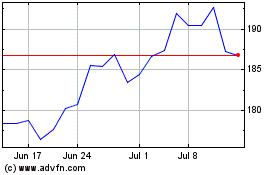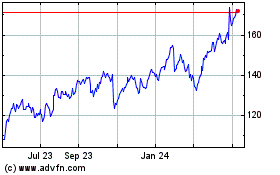By Dan Strumpf
China's Huawei Technologies Co., barred by the U.S. from buying
American technology, has found a lot of workarounds--but is having
a hard time replacing Google, on which it has relied for a
decade.
Without the search-and-software giant's apps, smartphone
fixtures around the world, the once-relentless march of Huawei's
phones is faltering. Overall smartphone demand globally suffered a
record fall in the first quarter, as the coronavirus ravaged the
world economy and upended supply chains. But Huawei's smartphone
shipments outside China dropped 35%, more than twice rival Samsung
Electronics Co.'s decline and four times Apple Inc.'s, according to
data tracker Canalys.
The collapse threatens Huawei's hard-won position as the No. 2
global cellphone brand after Samsung and the company's broader
consumer-gadgets business, a thriving area that last year
contributed more than half of its $122 billion in revenue.
The ban on buying from U.S. suppliers remains the most visibly
damaging of the many blows that the Trump administration has struck
against Huawei. The company has responded by reordering its supply
chain to bypass the U.S. and developing its own chips and other
replacement parts. It continues to rack up contracts to build 5G
networks globally.
Replacing the contributions of Alphabet Inc.'s Google has proved
tougher. Google's Android--which runs more than four-fifths of the
world's smartphones--is an open-source operating system, meaning
Huawei devices can still use it. But Google apps and other
proprietary software are off-limits for Huawei phones introduced
after the U.S. Commerce Department ban on American suppliers was
enacted last May.
Huawei is now launching devices with an in-house software
package, Huawei Mobile Services, that includes alternatives, such
as its own web browser to replace Google's Chrome and its own email
app to replace Gmail.
Its AppGallery app store is meant to replace Google Play, though
the blacklisting means the store lacks popular selections like
Facebook and Google's YouTube. Huawei says it has recruited more
than a million developers to produce programs for the store.
In the past year, Huawei has launched two flagship
smartphones--the P40 and the Mate 30--running on the homemade
software. Its share of China's smartphone market has grown in that
time, but consumers elsewhere say Google apps are hard to go
without, and have been slow to embrace Huawei's alternatives.
"You really don't see how many Google apps you use daily until
you don't have it anymore," said Allan Anthony, a New Jersey
smartphone enthusiast who recently purchased a P40 to complement
his iPhone. "AppGallery is cool, but very limited," he said,
offering "maybe about 40% of the apps I use every day"
Mr. Anthony, who works in information technology and reviews
smartphones on YouTube on the side, said he has tried workarounds,
including downloading Google apps from third-party websites, though
he said that option is off-limits after a software update. "I've
just been using what I can and making it work."
To fill out its store, Huawei said it is offering numerous
incentives to recruit app developers, including advertising in its
app store and what it says is generous revenue sharing. AppGallery,
launched in China in 2011 and made available globally in 2018, now
has more than 400 million monthly active users, Huawei says.
Neil Mawston, an executive director at Strategy Analytics,
estimated at least 90% of those users are in China. He and Huawei
said that reflects its earlier launch there. Google left China in
2010 after pressure from the Chinese government to censor search
results, so Chinese consumers are used to homegrown alternatives to
Google products.
Huawei's sales plunge outside China is reversing the strides it
had made in markets such as Western Europe, where it briefly
unseated Apple as No. 2 mobile-phone vendor before slipping to
third after its blacklisting, according to Canalys.
"There is a risk that Huawei's smartphone business will get
smaller, that it will become a China-centric business," said Edison
Lee, a Hong Kong-based telecom analyst at investment bank
Jefferies.
The Trump administration has noticed the company's
Google-replacement campaign. Two days before the P40 launch,
Undersecretary of State Keith Krach said in a tweet that he was
"very troubled" that developers were writing apps for Huawei,
saying "going in their app store compromises your consumers'
security/privacy." He added: "Many are watching closely."
A State Department spokeswoman declined to elaborate on the
tweet or make Mr. Krach available for an interview. A Google
spokesman declined to comment beyond a February statement that its
apps weren't available on recently launched Huawei devices.
Jerry Huang, a Huawei marketing director, said Huawei is
committed to protecting the privacy of its smartphone users. The
company has long disputed Washington's assertion that its products
are a security risk. Mr. Huang said any user data gathered by its
devices outside China is stored either on the devices or in local
data centers, and none is sent to China.
Developers that Huawei has signed as replacements include Dutch
navigation company TomTom NV, which is providing mapping, location
and traffic services. To replace Google's built-in web-searching
function, Huawei joined with French search engine Qwant. In
February, Huawei announced a deal with publisher News UK to bring
its newspaper apps to AppGallery.
A TomTom spokesman said the company doesn't share personal data
with third parties, including Huawei. Qwant Chief Executive Jean
Claude Ghinozzi said records of searches done through its app on a
Huawei device stay on Qwant's own servers. A News UK spokeswoman
declined to comment beyond a Huawei statement announcing the
partnership in March. News UK is owned by News Corp., which also
owns The Wall Street Journal.
Write to Dan Strumpf at daniel.strumpf@wsj.com
(END) Dow Jones Newswires
May 12, 2020 06:12 ET (10:12 GMT)
Copyright (c) 2020 Dow Jones & Company, Inc.
Alphabet (NASDAQ:GOOG)
Historical Stock Chart
From Mar 2024 to Apr 2024

Alphabet (NASDAQ:GOOG)
Historical Stock Chart
From Apr 2023 to Apr 2024
